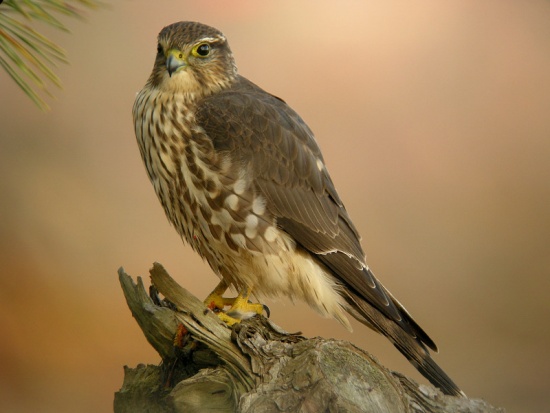m (Reverted edits by Nutcracker (Talk); changed back to last version by Wintibird) |
|||
| Line 7: | Line 7: | ||
==Distribution== | ==Distribution== | ||
| − | [[Image:Merlinc.jpg|thumb|350px|right|Male ''F. c. aesalon''<br />Photo by | + | [[Image:Merlinc.jpg|thumb|350px|right|Male ''F. c. aesalon''<br />Photo by the late '''[http://www.birdforum.net/gallery/showgallery.php?cat=500&ppuser=35827 Jim Wood]'''<br />East Lothian [[Scotland]]]] |
Breeds widely across the northern hemisphere, with some populations almost resident while others migrate south in winter. | Breeds widely across the northern hemisphere, with some populations almost resident while others migrate south in winter. | ||
Revision as of 06:38, 28 July 2015
- Falco columbarius
Aesalon columbarius
Identification
Length 24-33 cm (10-13 inches), wingspan 50-67 cm, weight 150-210 g (male), 190-255 g (female)
A smallish falcon with pointed wings and relatively short tail, and a less distinct facial 'moustache' bar than most falcons, just a slightly darker slash. Sexes differ in size, male smaller than female; male blue-grey to blackish above, with underparts buff to orangey, streaked darker; female brown, more heavily streaked below; juvenile and immature similar to female. See also Subspecies, below, for variation between specific populations.
Distribution
Breeds widely across the northern hemisphere, with some populations almost resident while others migrate south in winter.
In North America breeds over most of Alaska and Canada south of the tree-line and in the north-west and north-central USA. Winters from south-west Canada, the western and southern USA south through Mexico to Panama, in the West Indies and the northern coast of South America. Migrates south to the Caribbean, Central America, and northern South America; vagrant south to Bahia, Brazil.
In Europe breeds in Iceland and the Faroes, throughout northern Scandinavia, sporadically in the Baltic States and widespread across northern Russia. Also very patchily in the uplands of the north and west British Isles although now extremely rare in south-west England. Dispersive in south-west Iceland and the British Isles, but elsewhere a summer visitor, with mainland European birds migrating to coastal Britain, Denmark and southern Sweden south to the Mediterranean, and on some of the larger islands and in North Africa north of Sahara. Recorded as a vagrant north to Svalbard and south to Madeira and the Canary Islands.
In northern Asia occurs from the Urals east to the Pacific coast of Russia and Sakhalin and ranges south to the Tien Shan Mountains in Central Asia. Winters from the Middle East to the Himalayas, northern Indochina, China and Japan. A vagrant to Oman and Yemen.
Autumn movements take place mainly in September-October with the spring return in April-May.
Taxonomy
Genetic evidence suggests its closest relatives are Grey Kestrel and Dickinson's Kestrel, both from tropical Africa[3].
Subspecies
Eight or nine subspecies are usually recognised[1]:
- North America
- F. c. columbarius ("Taiga Merlin") breeds in Alaska and northern Canada, winters south across USA and Mexico. Medium tones.
- F. c. suckleyi ("Black Merlin") from British Columbia to northern California; resident or short-distance migrant. Very dark, to nearly black.
- F. c. richardsonii ("Richardson's Merlin") in the Great Plains; formerly migrated to the Gulf Coast region, but increasingly resident in Great Plains cities, hunting at bird feeders. Pale.
- Europe & Asia
- F. c. subaesalon breeds in Iceland and the Faroes and winters in the British Isles, rarely on European coasts from Norway to France; large and dark.
- F. c. aesalon breeds from Europe to northwestern Siberia, winters southern Europe and the Mediterranean region. Medium tones.
- F. c. insignis breeds in north-central Siberia and winters in China. Medium tones.
- F. c. pacificus breeds in northeast Siberia and winters in Japan. Medium tones. Some authors consider it synonymous with F. c. insignis.
- F. c. pallidus breeds in steppes of west-central Asia, winters south to India. Palest subspecies.
- F. c. lymani in the mountains of central Asia (eastern Altai, Tien Shan and western China); wintering area not reported. Medium tones.
There have been proposals to split the North American group from the European group, as they have more than 2% sequence divergence[2]; more recent data places them close, with no suggestion of paraphyly in the species with respect to any other falcons, though these authors also support this split[3].
Habitat
Breeds on moorland and heaths, tundra and boreal forest-edge. In winter on coastal farmland, marshes and other open habitats.
Behaviour
Hunts over open grassland, moors, coasts and mudflats; will also hunt out to sea to catch tired migrating birds. American Merlins are known for their aggressive behavior, even during migration going out of their way to mob larger birds of prey.
Diet
The most important food is small birds (primarily passerines and small waders) which are generally caught in flight.
Vocalisation
<flashmp3>Falco columbarius (song).mp3</flashmp3>
Listen in an external program
References
- Gill, F and D Donsker (Eds). 2015. IOC World Bird Names (version 5.2). Available at http://www.worldbirdnames.org/.
- Wink, M., et al. (1998). Molecular systematics of holarctic raptors (Order Falconiformes). In: Chancellor et al. (eds.): Holarctic Birds of Prey: 29-48.
- Fuchs, J., Johnson, J. A., & Mindell, D. P. (2015). Rapid diversification of falcons (Aves: Falconidae) due to expansion of open habitats in the Late Miocene. Molecular Phylogenetics and Evolution 82: 166–182.
Recommended Citation
- BirdForum Opus contributors. (2024) Merlin. In: BirdForum, the forum for wild birds and birding. Retrieved 22 December 2024 from https://www.birdforum.net/opus/Merlin
External Links






